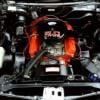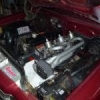Hanra should be able to help out a bit on this one?
Never had a great deal to do with them myself but first thing you need to do is get em in sync.with correct float setting,from memory there is two types of floats.
Take air cleaners off and use a piece of plastic tube to the ear and and place other end of tube somewhere near slide so
that you can hear the "pop" of induction noise,adjust the butterfly synchronizing adjusters till they all have the same level of noise.
The big nuts underneath are usually wound all the way up and then backed off so many turns as a starting point,dont remember the number of turns to be backed off,might be about 1-11/2,not sure.The nuts are used to adjust the idle mixture and you must take note how far you turn each one from the starting point so as to keep them even,you are actually moving the main get up and down when you adjust these nuts and if they are not all the same height it not only affects idle but also main mixture.
Getting the right size needle can be a bit tricky because there is quite a few available, start with something from an engine with similar sized cylinder that uses similar carb is what I would do.
The spring and dashpot oil weight also determine how rich or lean the carb will run.I could be wrong here but I think heavy spring tends to make them rich because the
piston has more weight to fight and thus wants to hold the piston and therefore the needle down which causes a strong signal at the venturi which pulls over more fuel for the
amount of air being used.
I figure the oil would have more to do with dampening how quickly the piston rises when accelerating and therefore affects not only off idle but also main mixture during the transition therefore affecting the entire fuel curve to some degree.
Not sure if that helps at all








 View Garage
View Garage








